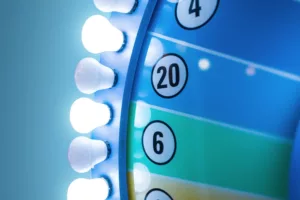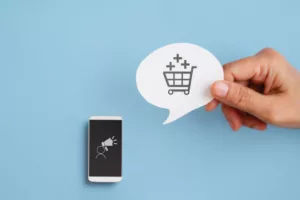Against a backdrop of consumer marketing fatigue, there is still hope. The marketing game is now one of the most powerful levers for engaging your audience and converting them into customers, or even brand ambassadors.
If you’re thinking of following the example of Balenciaga, Starbuck or Gémo by launching your own marketing quiz campaign, you’ll find the keys to maximising its impact and achieving your objectives in this article.
What is a game marketing campaign?
Gamification marketing (or game marketing) is a strategy that involves borrowing the codes of games (contests, board games and especially video games) to engage and retain your prospects or customers.
This fun concept invites consumers to perform an action (subscribe to your page, sign up for your newsletter, etc.) in exchange for the opportunity to take part in a game and win prizes.
In concrete terms, your interactive campaign can take the form of a gamified loyalty program, a quiz or even a collaboration with another brand.
4 good reasons to gamify your marketing
More and more brands are adopting gamified marketing because it offers a number of advantages.
In particular, it is a powerful lever for :
- Increase audience engagement. Games, and especially the rewards they bring, are a very effective remedy against scrolling. This strategy is therefore highly relevant for holding the attention of your target audience and reducing your bounce rate.
- Collect data (while remaining RGPD-compliant). Your prospects choose to voluntarily share their data in exchange for an entry ticket to your game.
- Increase brand awareness. Most marketing games involve subscribing to your page, sharing your publication on players’ profiles, or even generating content around your campaign (known as UGC). Either way, it’s a great way to extend your brand’s reach and generate leads.
- Converting new customers and building audience loyalty. If you reward participants with coupons or loyalty points, chances are they’ll buy (or redeem) from your brand.
5 steps and tips to launch a viral game marketing campaign
Passons maintenant aux choses sérieuses. Like any marketing strategy, an interactive campaign needs to be well thought out before it is launched. To maximize your return on investment, we recommend you follow these steps.
1. Identify your target and set clear objectives (engagement, conversion, etc.).
Before designing your marketing competitions, take the time to define who they will be aimed at. As one of the main benefits of this strategy is to collect data and convert prospects into customers, you need to have as precise an idea as possible of the target your brand wants to reach.
Start by identifying your persona (age, consumer habits, expectations of your company). Also be clear about your target’s relationship with your brand. Should your game marketing campaign enable you to convert new customers (and therefore generate leads), or engage your existing customers to build loyalty?
Take the time to list concrete objectives. What returns do you expect in terms of audience engagement, conversion or loyalty? Set yourself KPIs that you can monitor throughout your interactive campaign.
2. Choosing the right gamification marketing game format and rewards
You can then choose from a wide variety of formats marketing gamification. For example, you can choose from the following ideas:
- The multiple-choice quiz (with a timer to create tension and reference times to beat to boost competition between participants);
- Creative contests: for participants who are highly involved in your campaign.
- Instant Win: participants simply fill in a form to find out if they’ve won a prize.
- Score-based marketing games based on video game codes such as Tap Tap. Put your leads in competition and invite them to share.
To determine the most relevant type of marketing competition for your brand, take into account the habits of your target audience. Also, think carefully about your endowments. They need to be attractive enough to boost player engagement and increase brand loyalty. Here, too, you’ll be spoilt for choice, with exclusive discounts, product samples, VIP experiences with the brand and more.
3. Set up the promotional strategy for your interactive campaign
Once your marketing game is ready, choose the channels on which you’re going to promote it. Depending on your target and objectives, you can launch an interactive campaign on social networks, via your newsletter or directly at your point of sale/on your products (using a QR code).
Set up a consistent promotional calendar. Include teasing in advance of your campaign, regular follow-ups on identified channels throughout your campaign and on launch day. Finally, don’t forget to thank all participants and highlight the winners. Recognition is, in itself, a powerful incentive in your marketing game.
4. Engage participants in your marketing game to convert them or build loyalty
The conditions for taking part in your game marketing campaign vary according to the objectives you have set yourself. Use it as a lever to convert your prospects or retain your customers.
If you’re looking to generate leads, for example, you can ask participants to sign up for your newsletter, to share the contest publication on their networks, etc.
Keep in mind that the higher the value of your reward, the more you can add participation conditions to your benefit. Be careful, however, not to be too greedy, as this could slow players down.
5. Collect and analyze your data
As we explained in our guide to data collection, Google recently announced its intention to put an end to third-party cookies. Marketing games are therefore an RGPD and user-friendly alternative for collecting customer data. That’s right, This is called zero-party data, because it is voluntarily shared with you by your prospects.
So think about select the data you’re interested in, and keep your registration form as short as possible. Then take the time to analyze this data, in addition to the KPIs of your interactive campaign (such as conversion rate, sales, new subscribers, etc.) to measure its impact.
This will make it easier for you to improve what needs to be improved and optimize your next marketing contests!
Ready to launch your interactive campaign?
Creating marketing games has never been easier, thanks to our No Code platform. Test our solution by register for free right now!
If you have any questions, or need advice, don’t hesitate to contact us via the Live Chat at the bottom right of your screen.





